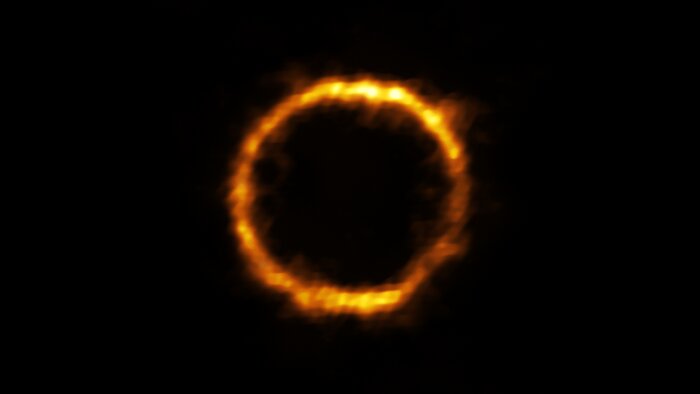Astronomers have observed a galaxy from when the universe was only 1.4 billion years old that is remarkably similar to our Milky Way. Although lacking spiral arms like our galaxy, this distant galaxy does display a rotating disc and a starry, central bulge—characteristics only thought to have developed in more modern galaxies. The findings challenge the conventional view that early galaxies were chaotic and less structured than galaxies that followed later in cosmic history.

The galaxy, designated SPT0418-47, is located 12 billion light-years away. Astronomers observed the distant object using the Atacama Large Millimeter/submillimeter Array (ALMA)—currently the largest telescope of its kind in the world. Yet even the most powerful instruments cannot resolve many details for objects as far away as SPT0418-47. Serendipitously, though, this distant galaxy aligned with a closer, foreground galaxy. The foreground galaxy's gravity bent and magnified light streaming from SPT0418-47—a phenomenon known as gravitational lensing—allowing ALMA to capture ample light for a thorough observation. Lensing actually caused SPT0418-47 to appear as a perfect circle around the foreground galaxy. A new computer modeling technique enabled researchers to reconstruct that ring shape into a whole image, thus showing SPT0418-47 as it naturally appears.

The distant galaxy possesses the most well-ordered galactic disk ever catalogued in such an early era for the universe. According to prevailing cosmological models, the universe originated as an ultra-hot, ultra-dense speck 13.8 billion years ago, expanding and cooling since then. The first galaxies full of stars started taking shape within a billion years or so as matter and dark matter clumped together, resulting in over-dense regions where galaxies arose and under-dense expanses where galaxies did not form. Many collisions and merging events occurred between these early galaxies, scrambling their shapes. Primordial galaxies seen to date have thus lacked the sort of evolved, stable structures of a bulge and a disk seen in our Milky Way and most other galaxies in the universe's more recent eons. The new characterization of SPT0418-47 suggests that, at least in some cases, young galaxies did manage to develop internal structure, a finding that will help advance both cosmological and galaxy formation paradigms.





